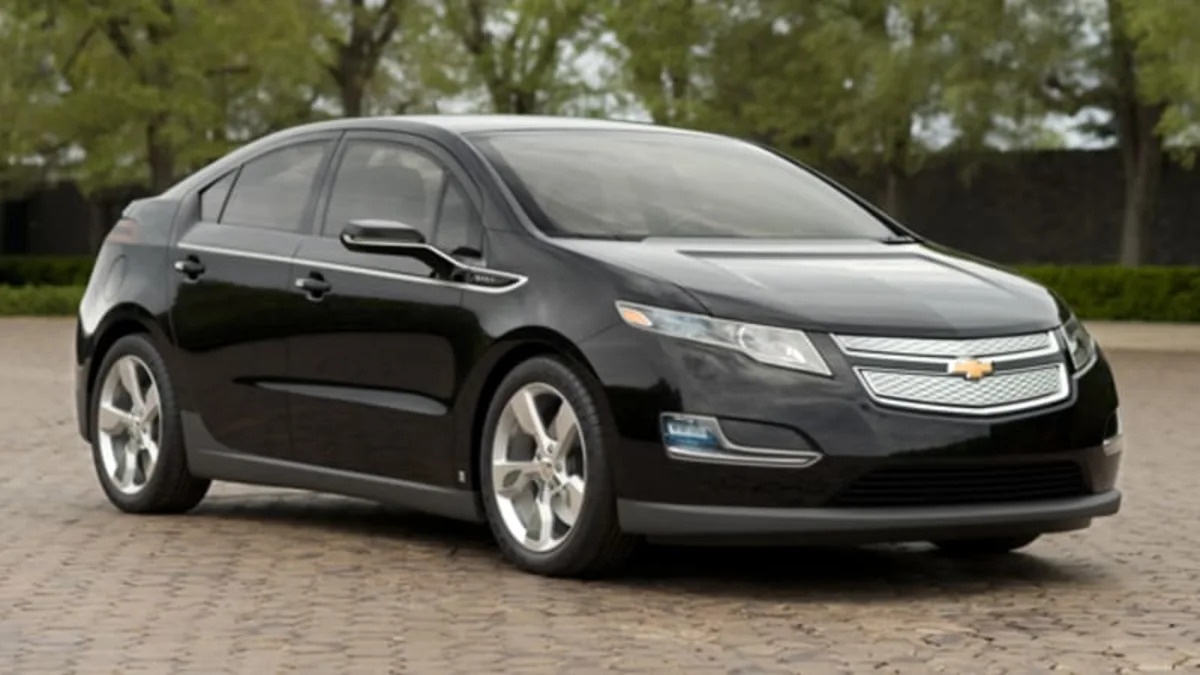2011 Chevy Volt - Click above for high-res image gallery
 A New World of Opportunity
A New World of Opportunity
Anyone out there read Inc. magazine? I don't either.
But I picked up the November 2009 issue at the October CAR "Business of Plugging In" event because it contained a very interesting feature called "The Connected Car" by Bernard Avishai, a business professor and writer at the Hebrew University of Jerusalem. "Want to get into the car business?" the subhead asks over a two-page photo of a Volt rolling chassis. "The imminent introduction of electric vehicles will make possible – in fact, will require – the creation of a vast ecosystem of entrepreneurial businesses."
"At ground level," the article begins, "electric cars like GM's Chevrolet Volt – due to be launched in November 2010 – are pretty much everything the U.S. economy is banking on. The cars promise innovative engineering and a resurgence of the American auto industry. They mean an America that is manufacturing things rather than just bundling financial instruments. Cosmetically, electric cars mean green technologies that will migrate to China, India and Brazil, where they will allow for Western styles of personal freedom...."
To be fair, the U.S. economy and manufacturing base need a lot more than EVs, beginning with tax breaks and incentives for all businesses, small and large, to begin hiring again. Once that begins and regular folks have money and confidence enough to invest in new vehicles, we know that a growing percentage of them will be EVs, many manufactured here. (more after the jump).
Avishai cautions that it won't be easy: "One recent analysis by the Oak Ridge National Laboratory assumed a scenario in which 25 percent of households drove electric cars and plugged in at 5 p.m. Up to 160 large power plants would be needed nationwide to supply the added electricity. Ed Kjaer, director of the electric transportation advancement program at Southern California Edison, warns that electric vehicles, each equal in demand to about a third of a house, would particularly tax distribution performers at the local level. (Each transformer handles the load for about 10 average size homes.)"
Then he cites Mike Rowland, Duke Energy director of advanced customer technology, who said: "If every American home had a Volt ... total power usage in the country would increase only about 10 percent. But what's crucial is load distribution: where and in what order the cars' battery packs are recharged – and from where the power is taken." Then he adds: "Even first-generation electric vehicles will have the capacity to tell the grid to fill their batteries immediately or, say, after midnight; eventually, they will be able to sync to your schedule...."
Here is where the challenge turns to opportunity, he says, because this "means entering a commercial landscape that mirrors the transformative industries of the 1980s and '90s: computers and software, switching and networking, consumer electronics converging with cellular technology. This landscape is full of start-ups and medium-size supplier businesses that play to American strengths: entrepreneurship, originality, comfort with the virtual."
Avishai lists six key areas of business opportunity in the EV ecosystem:
- Battery makers and integrators -- winners of today's high-stakes competition to make batteries lighter, cheaper and more powerful will be key suppliers
- Battery farmers -- new companies will emerge that re-purpose used batteries too weak for vehicle usage for energy storage elsewhere
- New parts suppliers -- mechanical systems driven by belts in conventional vehicles will be designed and developed by existing and new suppliers to be powered by electric motors
- Auto-telecom companies – will enable EVs to communicate directly with power companies with data on their locations, system condition, charging status and more
- Builders of the smart grid – America's 3,200 electric utilities will require massive technology and infrastructure upgrades
- The connectors – emerging businesses will design, build, install and maintain home and public charging stations and team with power companies to coordinate billing
As an example, he profiles an Arlington, VA start-up called GridPoint, which is "working with a number of partners to build the nation's first smart grid, in Boulder, CO, a $100 million project" and is "in discussions with virtually all automotive companies with an electric car in the pipeline" to get its grid communications software into all future EVs. But discussions don't always lead to agreements. Achieving communications software commonality across the EV industry could be a major challenge because software suppliers and some OEMs (most notably GM and Toyota) pride themselves in developing their own exclusive software.
 Still, there is wide recognition of the need. "We see companies like GridPoint managing what utilities do with data behind the door," Avishai quotes Volt Vehicle Line Director Tony Posawatz, "providing back to our drivers the charging, billing and other services that will maximize the cost effectiveness and environmental benefit of owning an electric vehicle."
Still, there is wide recognition of the need. "We see companies like GridPoint managing what utilities do with data behind the door," Avishai quotes Volt Vehicle Line Director Tony Posawatz, "providing back to our drivers the charging, billing and other services that will maximize the cost effectiveness and environmental benefit of owning an electric vehicle."
He cites Frank Weber, GM's global EV chief engineer until his recent promotion to head up product planning at Opel, on the need for EV-specific systems: "You want a new generation of regenerative brakes that capture energy when you apply the pedal. You want a sound system that worries about how much energy it is drawing...." Systems such as heating, air conditioning, steering and brakes, Weber added, will need new "power dynamic" components – "electric motors for everything. None of these components can be developed by GM alone or will be for GM alone. We have to work closely with new, smart suppliers."
And he discusses the critically important roles of government at all levels, from coordinating and streamlining enforcement of local and state codes to agreeing on and setting national and even global regulatory standards. The need is to speed and enable – not retard and complicate – the growth of electrically-driven vehicles and their necessary infrastructure.
"There are far too many living things in the emerging ecosystem to be anticipated by any government or major OEM," Avishai asserts. "It will take an implicit partnership of hundreds, perhaps thousands, of suppliers to fill out the technology. The key is to bring them into alignment. 'If governments act to consolidate standards,' Posawatz says, "they can really make a difference in catalyzing competition among suppliers.'"
My take is that would-be entrepreneurs willing to risk whatever money they can scrape together in a serious business to serve this emerging EV market and its customers – and willing to work their asses off to make it succeed – should strongly consider doing so. There should be some serious green available in the emerging business of "green" transportation.
Award-winning automotive writer Gary Witzenburg has been writing about automobiles, auto people and the auto industry for 21 years. A former auto engineer, race driver and advanced technology vehicle development manager, his work has appeared in a wide variety of national magazines including The Robb Report, Playboy, Popular Mechanics, Car and Driver, Road & Track, Motor Trend, Autoweek and Automobile Quarterly and has authored eight automotive books. He is currently contributing regularly to Kelley Blue Book (www.kbb.com), AutoMedia.com, Ward's Auto World and Motor Trend's Truck Trend and is a North American Car and Truck of the Year juror. Read his first column on The Business of Plugging In expo here.


Sign in to post
Please sign in to leave a comment.
Continue